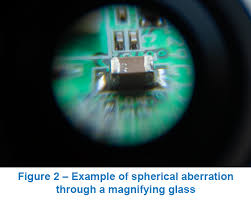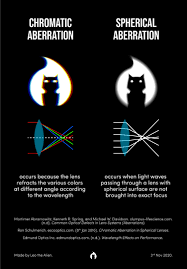Spherical aberration
Spherical aberration is an optical phenomenon that occurs when light rays passing through the periphery of a spherical lens or mirror focus at different points along the optical axis compared to those passing near the center. This discrepancy leads to a blurred or distorted image, as the lens fails to converge all incoming light to a single focal point.

Causes of Spherical Aberration
The primary cause of spherical aberration is the inherent geometry of spherical lenses or mirrors. In an ideal optical system, all incoming parallel light rays should converge at a single focal point. However, in spherical optics, rays that enter near the edges (peripheral rays) are refracted or reflected more than those entering near the center (paraxial rays). This variance causes peripheral rays to focus at different points along the optical axis, resulting in a blurred image.
Effects on Optical Systems
Spherical aberration significantly impacts the performance of optical systems by reducing image clarity and sharpness. In imaging devices like microscopes and cameras, it manifests as a halo or blur around the image, diminishing resolution. In laser systems, spherical aberration can cause beam spreading, leading to decreased precision. The degree of aberration is influenced by factors such as the aperture size and the refractive index of the lens material.
Methods of Correction
Several techniques are employed to mitigate spherical aberration:
Aspheric Lenses: Unlike spherical lenses, aspheric lenses have surfaces with non-spherical profiles. These designs allow for the correction of spherical aberration by ensuring that all incoming light rays converge at a single focal point.

Aperture Adjustment: Reducing the aperture size limits the entry of peripheral rays, which are primarily responsible for spherical aberration. This method improves image sharpness but may reduce brightness.
Lens Combinations: Combining multiple lenses with complementary aberrations can counteract the effects of spherical aberration. For instance, pairing a convex lens with a concave lens can help in balancing the aberrations.
Spherical Aberration Compensation Plates: These are specialized optical elements designed to counteract spherical aberration in systems where lens design modifications are impractical. They work by introducing compensatory phase shifts to the light passing through the system.
Spherical Aberration in the Human Eye
The human eye, with its nearly spherical cornea and lens, is susceptible to spherical aberration. This aberration can lead to decreased image quality on the retina, affecting visual clarity. Factors such as pupil size influence the extent of spherical aberration; larger pupils allow more peripheral rays, increasing aberration. While standard eyeglasses may not correct this issue, specialized contact lenses or surgical interventions can be employed to address it.
Implications in Astronomy
In telescopes, especially those with spherical mirrors, spherical aberration can blur the images of celestial objects. This was notably observed in the Hubble Space Telescope, which initially suffered from spherical aberration due to a manufacturing error in its primary mirror. The issue was later corrected using additional optical components designed to counteract the aberration.
Spherical aberration is a fundamental optical challenge arising from the geometry of spherical lenses and mirrors. Its effects can degrade the performance of various optical systems, from simple lenses to complex astronomical telescopes. Understanding its causes and implementing corrective measures are essential for optimizing image quality and system performance.
Faqs
Spherical aberration is a common optical issue that affects the clarity and focus of images produced by lenses and mirrors. Below are frequently asked questions to help you understand this phenomenon:
What is spherical aberration?
Spherical aberration occurs when light rays passing through a spherical lens or reflecting off a spherical mirror focus at different points along the optical axis. This results in a blurred or distorted image because the light does not converge at a single focal point. citeturn0search0
What causes spherical aberration?
The primary cause is the shape of the lens or mirror. In spherical optics, rays striking near the edge (periphery) are refracted or reflected differently than those near the center, leading to multiple focal points.
How does spherical aberration affect image quality?
It degrades image sharpness and clarity. Instead of focusing light to a single point, spherical aberration causes a spread of focal points, resulting in a blurred or smeared image.
Can spherical aberration occur in all optical systems?
Yes, any optical system using spherical lenses or mirrors can experience spherical aberration, including cameras, telescopes, microscopes, and the human eye.
How can spherical aberration be corrected or minimized?
Several methods exist to reduce spherical aberration:
Aspheric Lenses: Using lenses with non-spherical surfaces helps focus light rays to a common point.
Lens Combinations: Combining convex and concave lenses can counteract aberrations.
Aperture Adjustment: Reducing the aperture size limits peripheral rays, decreasing aberration but also reducing light intake.
Mirror Design: Employing parabolic mirrors instead of spherical ones in telescopes ensures that parallel incoming light rays focus at a single point.
Is spherical aberration wavelength-dependent?
Spherical aberration primarily depends on the geometry of the optical system rather than the wavelength of light. However, different wavelengths can experience varying degrees of refraction, leading to chromatic aberration, a separate but sometimes concurrent issue.
How does aperture size influence spherical aberration?
A larger aperture allows more peripheral rays, which are more prone to spherical aberration. Reducing the aperture limits these rays, thereby minimizing the aberration but also decreasing the amount of light entering the system.
What is the difference between positive and negative spherical aberration?
In positive spherical aberration, peripheral rays focus closer to the lens or mirror than central rays. In negative spherical aberration, peripheral rays focus farther away than central rays. The type depends on the specific curvature and design of the optical element.
How does spherical aberration affect telescopes?
In telescopes, spherical aberration causes stars and other celestial objects to appear blurred or smeared. This is particularly problematic in spherical mirrors with short focal ratios, where light from a distant point source does not converge at a single point. To mitigate this, telescope designs often incorporate parabolic mirrors or corrective lenses. citeturn0search10
Can spherical aberration be completely eliminated?
While it’s challenging to eliminate spherical aberration entirely, especially in simple optical systems, advanced designs using aspheric elements, corrective coatings, and precise engineering can significantly reduce its impact, resulting in high-quality, sharp images.
Understanding spherical aberration is crucial for optimizing optical systems in various applications, from photography to astronomy, ensuring clearer and more accurate visual representations.
To read more click here

Leave a Reply